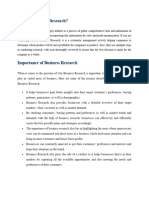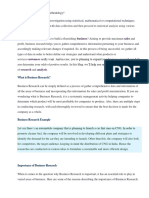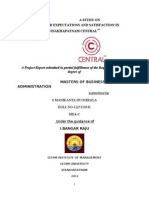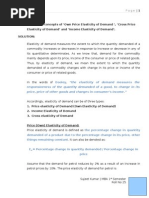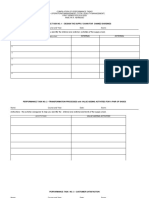Our Businesses: Retail Brands (16) Hospitality Brands (7) Mall Management
Our Businesses: Retail Brands (16) Hospitality Brands (7) Mall Management
Uploaded by
gayathrir_23047138Copyright:
Available Formats
Our Businesses: Retail Brands (16) Hospitality Brands (7) Mall Management
Our Businesses: Retail Brands (16) Hospitality Brands (7) Mall Management
Uploaded by
gayathrir_23047138Original Title
Copyright
Available Formats
Share this document
Did you find this document useful?
Is this content inappropriate?
Copyright:
Available Formats
Our Businesses: Retail Brands (16) Hospitality Brands (7) Mall Management
Our Businesses: Retail Brands (16) Hospitality Brands (7) Mall Management
Uploaded by
gayathrir_23047138Copyright:
Available Formats
Founded in 1973 in Bahrain, the Landmark Group has evolved into one of the largest and most successful
retail organizations in the Middle East. An international, diversified retail conglomerate that encourages entrepreneurship to consistently deliver exceptional value, the Group operates over 900 stores encompassing a retail presence of over 13 million sq. ft. across the Middle East, India, Egypt, Turkey, Yemen and Pakistan (franchise operation). The Group employs around 32,000 people.
Our businesses
As one of the largest retail conglomerates in the Middle East and India, the Landmark Group has a diverse portfolio of retail and hospitality brands. Retail Brands(16) Hospitality Brands(7) Mall Management(1)
The Landmark Group provides value-driven products for the entire family through a diverse portfolio of core retail brands: Landmark Brands
Franchise Brands
Hospitality brands The Landmark Group has also diversified into the leisure, food and hotels segments under the division, Landmark Hospitality:
Key facts & figures
Key Facts Turnover in excess of USD 3.8 billion Strong growth at a CAGR of 28% Presence in 15 countries with over 1000 stores Over 13.8 million sq. ft. of retail space Team of over 32,000 employees.
Key Figures Sales (USD million) Retail Space (Sq. ft. million) Goals by 2015 Retail footprint 17 million sq. ft. Turnover in excess of USD 5.2 billion Presence in 20 countries
Over 1200 stores
Hariharan Ramanathan CEO Ram, as he is popularly known, heads Max at the Landmark Group. Ram has a knack for launches starting with Splash in 1994, the Group's operations in Kuwait in 1996 and Lifestyle, India in June 2000. Today, Ram leads Max with aggressive expansion plans in the near future.
Micky Jagtiani Chairman Over 37 years now, Micky Jagtiani has led the Group with his business mantras of 'Retail Concepts', 'Estimating Market Potentials' and 'Key Man Policies.' Committed to social causes, Micky also founded LIFE - Landmark International Foundation for Empowerment. In keeping with the Group's tradition of making every shopping experience more rewarding and memorable, The Inner Circle, Landmark Group's loyalty programme allows members to enjoy exclusive benefits and privileges such as reward points and exciting offers.
Todays consumers demand choice and convenience. They mix and match channels according to their needs for product research, purchase and delivery. As cross-channel shopping behavior grows mainstream, the best way to evaluate and compare retail channels is to gauge their relative impact increasing customer satisfaction and loyalty. Customer satisfaction presents a versatile cross-channel metric to gauge the retailers strengths and weaknesses from the customers point of view. Since satisfaction drives behavior, a more thorough understanding of what drives multi-channel shoppers satisfaction will give retailers the insights they need to influence customer behavior in the short term and long term. In this way, customer satisfaction is harnessed to become a driving force in sales growth and increasing loyalty where each channel is optimized to meet the customers needs and exceed their expectations.
Why exceptional customer service is important You will retain your customers and your customers will become advocates for your business You will stand out from your competitors It makes the workplace more enjoyable therefore improves staff retention It shows your customers they are important
Customers will enjoy visiting you and and will buy more Customer service if done right will create word of mouth advertising It is the cheapest form of positive advertising Be prompt and prepared Listen well Be kind understanding and empathetic Customise Make specific recommendations based on what you know and what they are telling you. Deliver more than you promise every time Be polite and appreciative Make your actions fast and positive
The following is some ideas on how to keep your customers coming back time and again.
Customer Contentment Theory-deekay The theory of business is vital for determining its operation. Unless otherwise the aims are clear, efforts cannot be directed to achieve them. Every organization should know what its business is and what it should do to achieve its aims. A business should clearly spell out its purpose. The theory of business is vital for determining its operation. Unless otherwise the aims are clear, efforts cannot be directed to achieve them. Every organization should know what its business is and what it should do to achieve its aims. A business should clearly spell out its purpose. The purpose of every business is to create consumers. A consumer establishes the purpose of business. He is the one who pays for the goods and services provided by the business. A consumer has certain expectations from the goods he is purchasing. In fact he can be said to be buying Hopes. He sincerely hopes that he will satisfy his needs from the goods and services that he is buying. If the products lack quality, they are not liked by consumers and the business closes down for want of demand. All efforts of a business should be directed to satisfy consumers as it is the consumer who determines the use of economic services. Economic resources are used to produce those things which are demanded by the consumers. Now, a question arises as to how can the consumers be satisfied? This can be made possible through marketing and innovation. Marketing plays a significant role in promoting and well being of all business concerns. In reality the success of an organization depends upon its successful marketing. Marketing is sometimes called the distinguishing, the unique function of the business. A business is different from all other human organizations because of the fact that it markets a product or a service. Any organization that fulfills its aims through marketing goods and services is a business. Any organization in which marketing is either absent or secondary is not a business and should never be run as if it never was. It is marketing that satisfies the social values and needs of individuals. It is achieved through producing goods, supplying services and promoting innovations.
Describe phenomena as they exist. Descriptive studies generally take raw data and summarize it in a useable form. Can also be qualitative in nature if the sample size is small and data are collected from questionnaires, interviews or observations. Many scientific disciplines, especially social science and psychology, use this method to obtain a general overview of the subject. Some subjects cannot be observed in any other way; for example, a social case study of an individual subject is a descriptive research design and allows observation without affecting normal behavior. It is also useful where it is not possible to test and measure the large number of samples needed for more quantitative types of experimentation. These types of experiments are often used by anthropologists, psychologists and social scientists to observe natural behaviors without affecting them in any way. It is also used by market researchers to judge the habits of customers, or by companies wishing to judge the morale of staff. The results from a descriptive research can in no way be used as a definitive answer or to disprove a hypothesis but, if the limitations are understood, they can still be a useful tool in many areas of scientific research. The subject is being observed in a completely natural and unchanged natural environment. A good example of this would be an anthropologist who wanted to study a tribe without affecting their normal behavior in any way. True experiments, whilst giving analyzable data, often adversely influence the normal behavior of the subject. Descriptive research is often used as a pre-cursor to quantitative research designs, the general overview giving some valuable pointers as to what variables are worth testing quantitatively. Quantitative experiments are often expensive and time-consuming so it is often good sense to get an idea of what hypotheses are worth testing. Because there are no variables manipulated, there is no way to statistically analyze the results. Many scientists regard this type of study as very unreliable and unscientific. In addition, the results of observational studies are not repeatable, and so there can be no replication of the experiment and reviewing of the results. Descriptive research design is a valid method for researching specific subjects and as a precursor to more quantitative studies. Whilst there are some valid concerns about the statistical validity, as long as the limitations are understood by the researcher, this type of study is an invaluable scientific tool. Whilst the results are always open to question and to different interpretations, there is no doubt that they are preferable to performing no research at all. Read more: http://www.experiment-resources.com/descriptive-researchdesign.html#ixzz1Pk47marr
ADVANTAGES
DISADVANTAGES
SUMMARY
Descriptive research From Wikipedia, the free encyclopedia Descriptive research, also known as statistical research, describes data and characteristics about the population or phenomenon being studied. Descriptive research answers the questions who, what, where, when and how. Although the data description is factual, accurate and systematic, the research cannot describe what caused a situation. Thus, descriptive research cannot be used to create a causal relationship, where one variable affects another. In other words, descriptive research can be said to have a low requirement for internal validity. The description is used for frequencies, averages and other statistical calculations. Often the best approach, prior to writing descriptive research, is to conduct a survey investigation. Qualitative research often has the aim of description and researchers may boner follow-up with examinations of why the observations exist and what the implications of the findings are. In short descriptive research deals with everything that can be counted and studied. But there are always restrictions to that. Your research must have an impact to the lives of the people around you. For example, finding the most frequent disease that affects the children of a town. The reader of the research will know what to do to prevent that disease thus, more people will live a healthy life NON-PROBABILITY SAMPLING Non-probability sampling is a sampling technique where the samples are gathered in a process that does not give all the individuals in the population equal chances of being selected. by Joan Joseph Castillo (2009) In any form of research, true random sampling is always difficult to achieve. Most researchers are bounded by time, money and workforce and because of these limitations, it is almost impossible to randomly sample the entire population and it is often necessary to employ another sampling technique, the non-probability sampling technique. In contrast with probability sampling, non-probability sample is not a product of a randomized selection processes. Subjects in a non-probability sample are usually selected on the basis of their accessibility or by the purposive personal judgment of the researcher. The downside of this is that an unknown proportion of the entire population was not sampled. This entails that the sample may or may not represent the entire population accurately. Therefore, the results of the research cannot be used in generalizations pertaining to the entire population.
TYPES OF NON-PROBABILITY SAMPLING
CONVENIENCE SAMPLING Convenience sampling is probably the most common of all sampling techniques. With convenience sampling, the samples are selected because they are accessible to the researcher. Subjects are chosen simply because they are easy to recruit. This technique is considered easiest, cheapest and least time consuming. CONSECUTIVE SAMPLING Consecutive sampling is very similar to convenience sampling except that it seeks to include ALL accessible subjects as part of the sample. This non-probability sampling technique can
be considered as the best of all non-probability samples because it includes all subjects that are available that makes the sample a better representation of the entire population. QUOTA SAMPLING Quota sampling is a non-probability sampling technique wherein the researcher ensures equal or proportionate representation of subjects depending on which trait is considered as basis of the quota. For example, if basis of the quota is college year level and the researcher needs equal representation, with a sample size of 100, he must select 25 1st year students, another 25 2nd year students, 25 3rd year and 25 4th year students. The bases of the quota are usually age, gender, education, race, religion and socioeconomic status. JUDGMENTAL SAMPLING Judgmental sampling is more commonly known as purposive sampling. In this type of sampling, subjects are chosen to be part of the sample with a specific purpose in mind. With judgmental sampling, the researcher believes that some subjects are more fit for the research compared to other individuals. This is the reason why they are purposively chosen as subjects. SNOWBALL SAMPLING Snowball sampling is usually done when there is a very small population size. In this type of sampling, the researcher asks the initial subject to identify another potential subject who also meets the criteria of the research. The downside of using a snowball sample is that it is hardly representative of the population.
WHEN TO USE NON-PROBABILITY SAMPLING
This type of sampling can be used when demonstrating that a particular trait exists in the population. It can also be used when the researcher aims to do a qualitative, pilot or exploratory study. It can be used when randomization is impossible like when the population is almost limitless. It can be used when the research does not aim to generate results that will be used to create generalizations pertaining to the entire population. It is also useful when the researcher has limited budget, time and workforce. This technique can also be used in an initial study which will be carried out again using a randomized, probability sampling.
Read more: http://www.experiment-resources.com/non-probabilitysampling.html#ixzz1Pk5J145A
Weighted mean From Wikipedia, the free encyclopedia The weighted mean is similar to an arithmetic mean (the most common type of average), where instead of each of the data points contributing equally to the final average, some data
points contribute more than others. The notion of weighted mean plays a role in descriptive statistics and also occurs in a more general form in several other areas of mathematics. If all the weights are equal, then the weighted mean is the same as the arithmetic mean. While weighted means generally behave in a similar fashion to arithmetic means, they do have a few counter-intuitive properties, as captured for instance in Simpson's paradox. The term weighted average usually refers to a weighted arithmetic mean, but weighted versions of other means can also be calculated, such as the weighted geometric mean and the weighted harmonic mean. A chi-square test (also chi squared test or 2 test) is any statistical hypothesis test in which the sampling distribution of the test statistic is a chi-square distribution when the null hypothesis is true, or any in which this is asymptotically true, meaning that the sampling distribution (if the null hypothesis is true) can be made to approximate a chi-square distribution as closely as desired by making the sample size large enough. A test that uses the chi-square statistic to test the fit between a theoretical frequency distribution and a frequency distribution of observed data for which each observation may fall into one of several classes. Read more: http://www.answers.com/topic/chi-square-test#ixzz1Pk6IMgXW Studies often collect data on categorical variables that can be summarized as a series of counts. These counts are commonly arranged in a tabular format known as a contingency table. For example, a study designed to determine whether or not there is an association between cigarette smoking and asthma might collect data that could be assembled into a 22 table. In this case, the two columns could be defined by whether the subject smoked or not, while the rows could represent whether or not the subject experienced symptoms of asthma. The cells of the table would contain the number of observations or patients as defined by these two variables. The chi-square test statistic can be used to evaluate whether there is an association between the rows and columns in a contingency table. More specifically, this statistic can be used to determine whether there is any difference between the study groups in the proportions of the risk factor of interest. Returning to our example, the chi-square statistic could be used to test whether the proportion of individuals who smoke differs by asthmatic status. The chi-square test statistic is designed to test the null hypothesis that there is no association between the rows and columns of a contingency table. This statistic is calculated by first obtaining for each cell in the table, the expected number of events that will occur if the null hypothesis is true. When the observed number of events deviates significantly from the expected counts, then it is unlikely that the null hypothesis is true, and it is likely that there is a row-column association. Conversely, a small chi-square value indicates that the observed values are similar to the expected values leading us to conclude that the null hypothesis is plausible. The general formula used to calculate the chi-square (X2) test statistic is as follows: where O = observed count in category; E = expected count in the category under the null hypothesis; df = degrees of freedom; and c, r represent the number of columns and rows in the contingency table. The value of the chi-square statistic cannot be negative and can assume values from zero to infinity. The p-value for this test statistic is based on the chi-square probability distribution and is generally extracted from published tables or estimated using computer software programs. The p-value represents the probability that the chi-square test statistic is as extreme as or more extreme than observed if the null hypothesis were true. As with the t and F
distributions, there is a different chi-square distribution for each possible value of degrees of freedom. Chi-square distributions with a small number of degrees of freedom are highly skewed; however, this skewness is attenuated as the number of degrees of freedom increases. In general, the degrees of freedom for tests of hypothesis that involve an rc contingency table is Table 2 Expected values for data presented in a two-by-two table SOURCE: Courtesy of author. Variable 1 Variable 2 Total Yes No Yes (a+b)(a+c)/n (a+b)(b+d)/n a+b No (c+d)(a+c)/n (c+d)(b+d)/n c+d Total a+c b+d n equal to (r7minus;1)(c1); thus for any 22 table, the degrees of freedom is equal to one. A chi-square distribution with one degree of freedom is equal to the square root of the normal distribution, and, consequently, either the chi-square or standard normal table can be used to determine the corresponding p-value. The chi-square test is most widely used to conduct tests of hypothesis that involve data that can be presented in a 22 table. Indeed, this tabular format is a feature of the case-control study design that is commonly used in public health research. Within this contingency table, we could denote the observed counts as shown in Table 1. Under the null hypothesis of no association between the two variables, the expected number in each cell under the null hypothesis is calculated from the observed values using the formula outlined in Table 2. The use of the chi-square test can be illustrated by using hypothetical data from a study investigating the association between smoking and asthma among adults observed in a community health clinic. The results obtained from classifying 150 individuals are shown in Table 3. As Table 3 shows, among asthmatics the proportion of smokers was 40 percent (20/50), while the corresponding proportion among asymptomatic individuals was 22 percent (22/100). By applying the formula presented in Table 2, for the observed cell counts of 20, 30, 22, and 78 (Table 3) the corresponding expected counts are 14, 36, 28, and 72. The observed and expected counts can then be used to calculate the chi-square test statistic as outlined in Equation 1. The resulting value of the chi-square Table 3 Hypothetical data showing chi-square test SOURCE: Courtesy of author. Ever smoke cigarettes Symptoms of asthma Total Yes No Yes 20 30 50 No 22 30 100 Total 42 108 150 test statistic is approximately 5.36, and the associated p-value for this chi-square distribution that has one degree of freedom is 0.02. Therefore, if there was truly no association between smoking and asthma, there is a 2 out of 100 probability of observing a difference in proportions that is at least as large as 18 percent (40%22%) by chance alone. We would therefore conclude that the observed difference in the proportions is unlikely to be explained by chance alone, and consider this result statistically significant.
Because the construction of the chi-square test makes use of discrete data to estimate a continuous distribution, some authors will apply a continuity correction when calculating this statistic. Specifically, where OiEi is the absolute value of the difference between Oi and Ei and the term 0.5 in the numerator is often referred to as Yates correction factor. This correction factor serves to reduce the chi-square value, and, therefore, increases the resulting p-value. It has been suggested that this correction yields an overly conservative test that may fail to reject a false null hypothesis. However, as long as the sample size is large, the effect of the correction factor is negligible. When there is a small number of counts in the table, the use of the chi-square test statistic may not be appropriate. Specifically, it has been recommended that this test not be used if any cell in the table has an expected count of less than one, or if 20 percent of the cells have an expected count that is greater than five. Under this scenario, the Fisher'sexact test is recommended for conducting tests of hypothesis.
You might also like
- Fast-Track Your Business: A Customer-Centric Approach to Accelerate Market GrowthFrom EverandFast-Track Your Business: A Customer-Centric Approach to Accelerate Market GrowthNo ratings yet
- A Study of Customer Satisfaction Toward Service Quality in Retail With Referance To Reliance SmartNo ratings yetA Study of Customer Satisfaction Toward Service Quality in Retail With Referance To Reliance Smart75 pages
- Business Research Method: Superior University Lahore Raiwind Road CampusNo ratings yetBusiness Research Method: Superior University Lahore Raiwind Road Campus5 pages
- A Study On Marketing Strategies of Haldirams50% (2)A Study On Marketing Strategies of Haldirams70 pages
- Unit 2 Types of Marketing Research ???? CXFVNo ratings yetUnit 2 Types of Marketing Research ???? CXFV35 pages
- Direct Marketing - A Case Study of Amway Enterprises: A Project Report ONNo ratings yetDirect Marketing - A Case Study of Amway Enterprises: A Project Report ON70 pages
- Chapter 1 Introduction Customer SatisfactionNo ratings yetChapter 1 Introduction Customer Satisfaction9 pages
- Best Practices (Review and Analysis of Hiebeler, Kelly and Ketteman's Book)From EverandBest Practices (Review and Analysis of Hiebeler, Kelly and Ketteman's Book)No ratings yet
- Define Marketing. Distinguish Product Marketing and Services Marketing With Suitable50% (2)Define Marketing. Distinguish Product Marketing and Services Marketing With Suitable24 pages
- Market Research and Consumer Behavior Assignment 1100% (1)Market Research and Consumer Behavior Assignment 13 pages
- Consumer Behavior Definition, Factors and Methods QuestionProNo ratings yetConsumer Behavior Definition, Factors and Methods QuestionPro1 page
- Project Report Synopsis Effect of Loyalty Programs in Different Stores PDFNo ratings yetProject Report Synopsis Effect of Loyalty Programs in Different Stores PDF14 pages
- Customer Relationship Management: CustomersNo ratings yetCustomer Relationship Management: Customers2 pages
- Module 1 The Role of Marketing Research 1No ratings yetModule 1 The Role of Marketing Research 115 pages
- A Study On Customer Expectations and Satisfaction in Visakhapatnam CentralNo ratings yetA Study On Customer Expectations and Satisfaction in Visakhapatnam Central56 pages
- "Elevate Your Entrepreneurial Journey Unleashing the Power of Startup Success": BusinessFrom Everand"Elevate Your Entrepreneurial Journey Unleashing the Power of Startup Success": BusinessNo ratings yet
- From Zero to Growth: A Comprehensive Guide for EntrepreneursFrom EverandFrom Zero to Growth: A Comprehensive Guide for EntrepreneursNo ratings yet
- The Golden Rules of Practical Marketing: What Every Business Owner Must KnowFrom EverandThe Golden Rules of Practical Marketing: What Every Business Owner Must KnowNo ratings yet
- Summary: Hidden in Plain Sight: Review and Analysis of Joachimsthaler's BookFrom EverandSummary: Hidden in Plain Sight: Review and Analysis of Joachimsthaler's BookNo ratings yet
- Basics of Behavioral Science in Marketing: Q&A for EntrepreneursFrom EverandBasics of Behavioral Science in Marketing: Q&A for EntrepreneursNo ratings yet
- Chapter - Ii Bar and Beverage Service OperationNo ratings yetChapter - Ii Bar and Beverage Service Operation61 pages
- Project Report: Comparative Study of MARKETING Strategies of Vodafone & AIRTELNo ratings yetProject Report: Comparative Study of MARKETING Strategies of Vodafone & AIRTEL80 pages
- Oakley V Shenzhen Sailvan Ecommerce - ComplaintNo ratings yetOakley V Shenzhen Sailvan Ecommerce - Complaint30 pages
- Market Segmentation, Targeting and PositioningNo ratings yetMarket Segmentation, Targeting and Positioning14 pages
- Motorcycle Industry - Case Study AnalysisNo ratings yetMotorcycle Industry - Case Study Analysis5 pages
- Fast-Track Your Business: A Customer-Centric Approach to Accelerate Market GrowthFrom EverandFast-Track Your Business: A Customer-Centric Approach to Accelerate Market Growth
- A Study of Customer Satisfaction Toward Service Quality in Retail With Referance To Reliance SmartA Study of Customer Satisfaction Toward Service Quality in Retail With Referance To Reliance Smart
- Business Research Method: Superior University Lahore Raiwind Road CampusBusiness Research Method: Superior University Lahore Raiwind Road Campus
- Direct Marketing - A Case Study of Amway Enterprises: A Project Report ONDirect Marketing - A Case Study of Amway Enterprises: A Project Report ON
- Best Practices (Review and Analysis of Hiebeler, Kelly and Ketteman's Book)From EverandBest Practices (Review and Analysis of Hiebeler, Kelly and Ketteman's Book)
- Define Marketing. Distinguish Product Marketing and Services Marketing With SuitableDefine Marketing. Distinguish Product Marketing and Services Marketing With Suitable
- Market Research and Consumer Behavior Assignment 1Market Research and Consumer Behavior Assignment 1
- Consumer Behavior Definition, Factors and Methods QuestionProConsumer Behavior Definition, Factors and Methods QuestionPro
- Project Report Synopsis Effect of Loyalty Programs in Different Stores PDFProject Report Synopsis Effect of Loyalty Programs in Different Stores PDF
- A Study On Customer Expectations and Satisfaction in Visakhapatnam CentralA Study On Customer Expectations and Satisfaction in Visakhapatnam Central
- "Elevate Your Entrepreneurial Journey Unleashing the Power of Startup Success": BusinessFrom Everand"Elevate Your Entrepreneurial Journey Unleashing the Power of Startup Success": Business
- From Zero to Growth: A Comprehensive Guide for EntrepreneursFrom EverandFrom Zero to Growth: A Comprehensive Guide for Entrepreneurs
- The Golden Rules of Practical Marketing: What Every Business Owner Must KnowFrom EverandThe Golden Rules of Practical Marketing: What Every Business Owner Must Know
- Summary: Hidden in Plain Sight: Review and Analysis of Joachimsthaler's BookFrom EverandSummary: Hidden in Plain Sight: Review and Analysis of Joachimsthaler's Book
- Basics of Behavioral Science in Marketing: Q&A for EntrepreneursFrom EverandBasics of Behavioral Science in Marketing: Q&A for Entrepreneurs
- Project Report: Comparative Study of MARKETING Strategies of Vodafone & AIRTELProject Report: Comparative Study of MARKETING Strategies of Vodafone & AIRTEL














